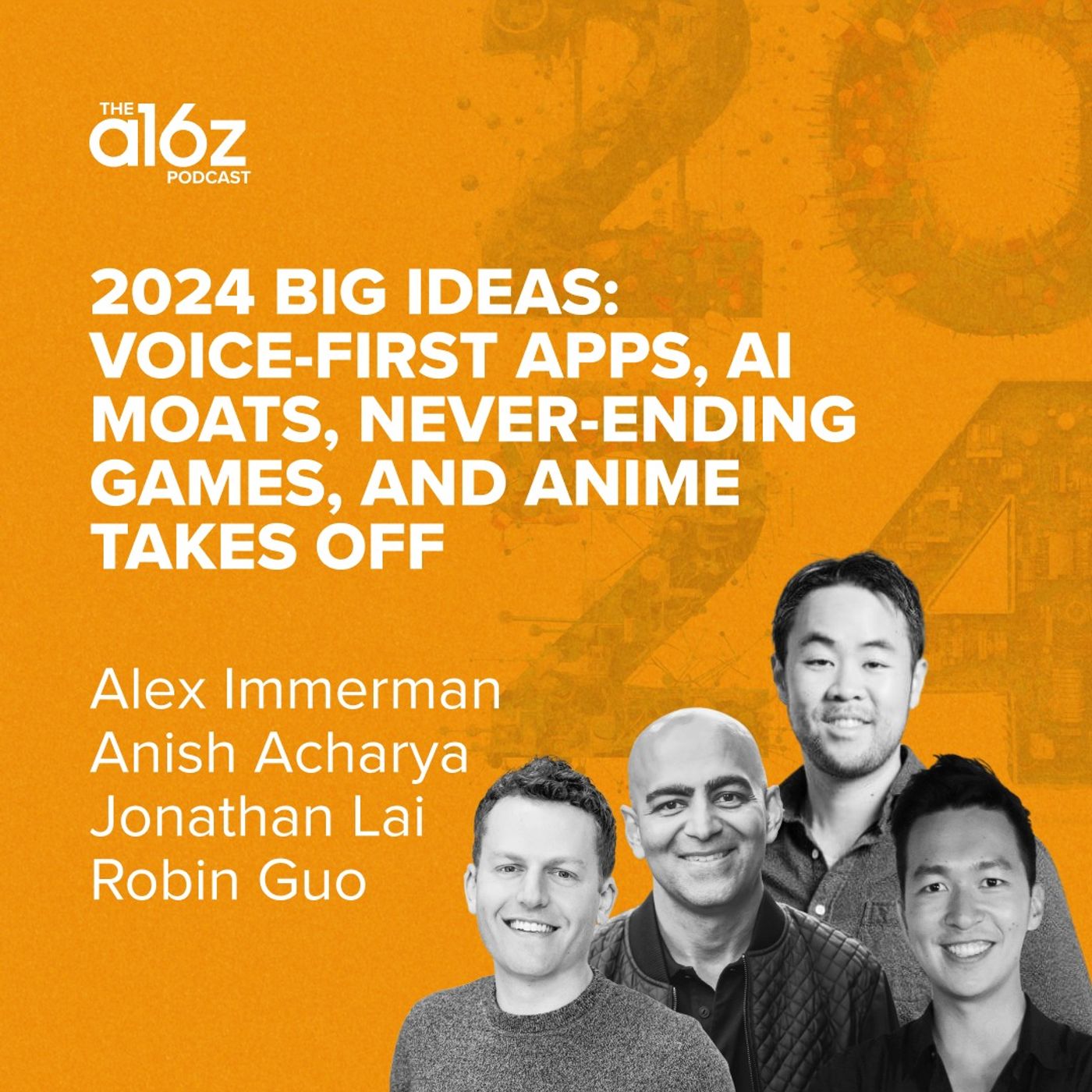Podcast Summary
Voice technology becoming a new way to interact with productivity apps: Voice technology, fueled by AI and language model advancements, is poised to revolutionize productivity apps, offering new and innovative experiences that were previously impossible.
Voice technology, which has long been anticipated as a game-changer for interacting with technology, is finally gaining traction due to advancements in AI and large language models. Manish Acharya, a GP on Andreessen Horowitz's consumer investing team, believes that voice will become a new way to interact with productivity apps, as humans unconsciously expect voice interactions to be flexible and cognitively sophisticated. However, incumbent productivity providers may not prioritize voice-first experiences, making it an intriguing area for investment. Despite past disappointments with voice technology, such as Alexa and other past-generation voice assistants, the potential for voice to revolutionize productivity apps is now a reality, thanks to the advances in AI and language models. This shift in interaction modality could lead to new and innovative productivity apps that have previously never been possible.
Reaching the final 10% in AI technologies: New voice-first technologies enable us to reach near-full functionality in AI, with innovative applications like Tab and ChatGPT's voice module leading the way. Expect unexpected voice-first experiences, like a voice-first inbox or a voice-first companion, to make everyday tasks more convenient and accessible.
The last 10% of achieving full functionality in AI technologies, particularly in areas like self-driving and interactive voice, requires a significant amount of effort and a technological shift. Existing apps may not be equipped to build voice-first experiences due to the need to modify workflows and meet consumer expectations. However, new technologies are making it possible to reach the 99% mark, and we're already seeing innovative voice-first applications like Tab and ChatGPT's voice module. As this technology continues to advance, we can expect to see more significant and unexpected experiences that go beyond what we currently imagine with voice, such as a voice-first inbox or even a voice-first companion like in the movie "Her." These developments have the potential to make everyday tasks more convenient and accessible to everyone.
Exploring the Future of Voice Interaction: Voice interaction offers unique advantages, but doesn't replace screens. Builders should start small, focus on strengths, and address challenges for successful implementation.
Voice interaction is an emerging technology that could significantly change how we engage with digital products, but it's not a replacement for existing modalities. Companies and developers should consider the unique advantages of voice and screen interfaces and find ways to complement each other. For new builders, the key is to start small and build something useful, while existing companies should focus on their strengths and gradually incorporate voice interaction where it makes sense. However, there are challenges, such as customer onboarding and social acceptance, that need to be addressed. Overall, the voice-first paradigm presents opportunities for expansion and innovation, but it's important to understand its limitations and potential impact on users.
Great user experiences can create a moat in consumer AI: In the consumer AI market, exceptional user experiences around specific use cases can differentiate companies and create switching costs, network effects, and brand empowerment
In the rapidly evolving world of consumer AI, user experience (UX) may become a key differentiator for companies, potentially surpassing the importance of having the best foundational models. Alex Zimmerman, a partner at 16z, argues that as model access becomes more widespread, consumer AI apps will break out by delivering unique and exceptional user experiences around specific use cases. This shift towards prioritizing UX could raise switching costs, strengthen network effects, and empower brands. Instagram, for instance, is a prime example of how a great user experience can create a moat in a technology paradigm shift. However, some might argue that UX can be easily copied. While it's true that UX can be replicated, creating a magical user experience that keeps users engaged and loyal is a challenging task. Companies that can succeed in this area will have a competitive edge.
Building apps with AI models as a new primitive: Differentiating through user experience and workflows is crucial for entrepreneurs using AI models in their apps, rather than just relying on the model's capabilities alone.
As AI models become more democratized and affordable, the landscape for consumer apps will broaden, allowing developers to build applications using models as a new primitive, similar to storage or geolocation. However, differentiating through user experience and workflows will still be crucial for entrepreneurs to avoid being displaced by larger model providers. Building a defensible business doesn't necessarily require creating a unique model. Instead, adding value through differentiated user experiences, such as multiplayer modes or model aggregation, can set apps apart. Quora's AI product, Po, is an example of this approach, as it aggregates multiple models and allows users to share and continue conversations in a multimodal environment. Looking ahead, shared experiences are expected to become more common and multimodal, offering exciting opportunities for innovative use cases in 2024 and beyond.
Revolutionizing gaming with AI technology: AI's integration into gaming leads to personalized, engaging experiences, with decreasing costs making it accessible to more, potentially resulting in groundbreaking innovations.
The integration of advanced AI technology into various industries, including gaming, will lead to more personalized and engaging experiences. With the development of open source models reaching parity with closed source models, the cost to access these technologies is decreasing, making them more accessible to a wider audience. This democratization of AI technology will lead to an influx of new companies and ideas, potentially resulting in groundbreaking innovations that are currently unpredictable. AI's ability to create lifelike companions and emergent social behavior, as well as personalized character builders and narrative systems, will revolutionize the nature of games themselves, leading to never-ending, highly engaging experiences. This is an exciting time for the future of AI and its applications.
AI Transformation in Gaming: Two Waves: 87% of game studios use AI tools, transforming game creation. AI-native games offer dynamic worlds, lifelike companions, and endless experiences.
The gaming industry is on the brink of a major transformation with the integration of artificial intelligence (AI). This transformation is happening in two waves. The first wave is about using AI tools to build games faster and of higher quality. This wave is already underway, with 87% of game studios using generative AI tools, and the impact being rated as transformational by the majority. The second wave is about creating entirely new AI-native games, with dynamic worlds, lifelike AI companions, and never-ending experiences. While we're still in the early stages of seeing what these new AI-native game experiences might look like, the potential is enormous. The inclusion of AI in games is not just about optimizing existing games, but about creating a fully new game environment. This includes designing games that are "good alone" (can be played single player or with AI), "great with AI" (elevating AI agents to be core gameplay elements), and "best with friends" (human interaction remains an essential part of gaming). The confidence in the popularity of these games comes from the fact that many of the biggest games today already use AI for onboarding and practice, and the promise of AI companions that can learn from players and provide a more engaging experience.
Integration of AI in Gaming: Old Concept, New Opportunities: AI in gaming is not a new concept, but the use of AI for personalization and companions can deepen player engagement and create new opportunities for both incumbents and newcomers.
The integration of AI in games, whether it's through AI companions or hyper personalization, is not a new concept. Games have been using AI for decades, from prescripted AI companions like Cortana in Halo, to fully fleshed out AI companions like Ellie in The Last of Us, which have led to deep attachments from players. Personalization in games, such as character builders and virtual clothing, is also nothing new and has been a significant revenue driver. The use of AI in games is not inventing entirely new consumer behavior but making it easier for players to do what they already want. The incumbents in the gaming industry are already investing in AI tools and infrastructure, but it's also an opportunity for new entrants to innovate and differentiate themselves. The future of gaming with AI will likely benefit both incumbents and newcomers, as they find new ways to engage and build communities in these communal interactive environments.
The future of AI native game development might be led by startups and new teams: The future of AI game development may not follow the same path as traditional game development, with startups and new teams potentially leading the way in innovation and new business models.
The future of game development, particularly in the realm of AI native games, may not be dominated by the largest developers due to their business models and risk aversion. Instead, startups and new teams with fresh perspectives are more likely to create the most innovative AI native experiences. These experiences may not even be described as games but share fundamental similarities. As these new forms of gaming emerge, business models may also evolve, with potential shifts towards subscription-based or other non-traditional revenue streams. Developers should keep in mind that the cost structure of creating and rendering AI-driven content may differ significantly from traditional game development. Additionally, the emergence of new gaming paradigms often brings in new demographics and expands the total gaming market. Therefore, it's essential for developers to remain open to new ideas and business models as the landscape of gaming continues to evolve.
Monetizing AI games through subscription models: AI games will shift towards subscription models to monetize user time or influence costs, with opportunities for innovation in game design and monetization strategies.
The future of AI games lies in subscription models, as traditional free-to-play and premium game models may not be profitable due to high influence costs. Game developers will need to find ways to monetize users' time or influence cost, possibly through virtual currencies or subscription fees. This paradigm of balancing time versus money already exists in some free-to-play games, and game developers will need to design around it. The opportunity for innovation in AI games is vast, and builders in the ecosystem should focus on reimagining their favorite game genres with generative AI at their core.
Small teams and anime disrupt the games industry: Small teams like those behind DOTA, PUBG, and Counter Strike can innovate and disrupt the $200 billion games industry. Anime, originating from Japanese comics, is a successful genre with broad appeal and flexibility, generating significant revenue through games like Genshin Impact, Hawkeye's Star Rail, and Zelda Tears of the Kingdom.
Small teams and new paradigms can disrupt the games industry, as seen with iconic games built by small teams like DOTA, PUBG, and Counter Strike. The potential for AI game teams to innovate and disrupt the $200 billion market is immense. On the other hand, anime, a unique art style originating from Japanese comics, has become one of the highest grossing genres in the games industry due to its broad appeal and ability to incorporate various components leading to deep player engagement. Anime's success is evident in the revenue generated by games like Genshin Impact, Hawkeye's Star Rail, and Zelda Tears of the Kingdom. Anime's flexibility and wide fan base set it apart, making it a genre that transcends different games, genres, and art styles.
Anime games offer unique opportunities for developers and high revenue through player engagement: Anime games offer a diverse audience, employ monetization strategies, and have high revenue potential through gacha systems and dedicated fan bases.
Anime games offer a unique opportunity for developers to cater to a large and diverse audience, combining various genres and player profiles. These games often employ monetization strategies such as battle passes and in-app purchases, but the gacha component is what sets anime games apart and drives high revenue through player engagement and high average revenue per user (ARPU). The gacha system, inspired by Japanese gachapon machines, allows players to spend money to obtain desirable characters, creating a sense of excitement and potential high spending depth. Despite its growing popularity, anime games have not been fully capitalized on by the masses, possibly due to their niche origins and the passionate, dedicated fan base that keeps to itself. However, with more mainstream recognition and acceptance, the potential for growth and investment in this trend is significant.
Anime genre's popularity and success in gaming: Passionate developers, specific archetypes, lower cost, and new technologies contribute to anime genre's success in gaming
The anime genre in gaming has been gaining mainstream popularity and success due to its devoted fan base and unique art style. Developers who are passionate about the medium and understand its specific archetypes and character designs have been able to create successful anime games. Mahoyo, as an example, has been successful by getting the genre's specifics right and building up their capabilities over time. The relatively lower cost of developing anime-style games compared to more complex games allows for both established companies and startups to thrive in the space. New technologies like AI and XR also offer opportunities to enhance and invent new anime games. AI can generate high-quality assets for anime games, while XR could offer innovative new mediums for anime-style experiences.
Anime gaming industry growth and potential on XR platform: The anime gaming industry generates significant revenue and is expected to continue growing, with exciting potential on the XR platform for new game loops and innovation.
The anime gaming industry is experiencing significant growth and revenue, with millions being generated per month for some games. This trend is expected to continue in 2024, and the potential for new and innovative game loops on the XR platform is exciting. The speaker expressed his enthusiasm for the platform's development and the creativity of new developers. Anime games have a large and engaged audience, making it an intriguing area for investment and innovation. If you're interested in exploring more big ideas, check out a16z.com/big-ideas-2024 for a full list of over 40 ideas, featuring partners from various teams. The future of technology and gaming is promising, and it's time to build.



